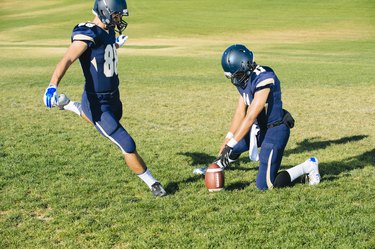
Kicking a football -- either a round soccer ball, oval American or rugby ball -- uses a lot of muscles and joints. A successful kick requires good eye-foot coordination, balance, accuracy, skill and power. Kicking is predominately a lower-body activity but your whole body is involved in maintaining balance and stability.
Bones and Joints
Video of the Day
Kicking a football uses all of the bones and joints in your lower body. The tarsals, metatarsals and phalanges of your foot provide the contact surface that strikes the ball. The tibia and tarsals form your ankle joint, which must stay slightly flexed but rigid when you kick so that no power is lost. Your knee joint, consisting of the tibia and femur, extends as your thigh muscles contract and your hip, which is made up of your femur and ilium, swings forward in a movement called hip flexion.
Video of the Day
Muscles of the Lower Leg
The primary muscles in your lower leg used in kicking a football are on opposite sides of your tibia, or shin bone. Your gastrocnemius and soleus muscles, collectively called your calf, contract to extend your ankle in a movement called plantar flexion, while the muscles on the front of your tibia -- tibialis anterior -- contracts to hold your ankle rigid. This type of muscle action is called an isometric contraction, which means that while these muscles are generating tension, they are not causing any actual joint movement but merely hold your ankle in place.
Knee Extension
Much of the power for kicking a football comes from the action of straightening your knee. This action, called knee extension, is the result of the contraction of the muscles on the front of your thigh. These muscles are called your quadriceps, which are made up of group of four individual muscles -- the vastus lateralis, rectus femoris, vastus medialis and vastus intermedius -- that share a common insertion point at the top of your tibia just below your patella, or kneecap.
Hip Flexion
Swinging your femur forward from your hip is a movement called hip flexion. Hip flexion is the largest joint action when kicking a football, because it starts from a position of extension and finishes with a significant follow-through. The main muscles responsible for hip flexion are psosas major, psosas minor and iliacus, which are collectively known as Iliopsoas, or hip flexors. These three muscles work with your quadriceps muscle rectus femoris and are responsible for the majority of the power required for kicking a football. To allow hip flexion to occur, your three hamstring muscles -- semitendinosus, semimembranosus and biceps femoris -- must relax. Tight hamstrings may hamper your kicking ability.
Notable Stabilizers
While the muscles listed are responsible for the majority of the movements necessary to kick a football, a number of muscles work to hold various parts of your body steady so your kick is delivered from a solid base of support. These muscles, collectively called stabilizers, include your rectus abdominus or abdominal muscles, your erector spinae muscles or back muscles, your gluteal muscles in your butt.